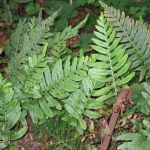| Common Name: |
Polypody |
| Botanical Name: |
Polypodium vulgare |
| Genus: |
Polypodium |
| Family: |
Polypodiaceae |
| Native Location: |
Europe, Africa, and E asia, mostly in northern or upland areas. |
| Cultivation: |
Moist, well-drained, rich soil in semi-shade. Leaves may be damaged by rust. |
| Propagation: |
By spores sown when ripe at 15-16°C (59-61°F); by division in spring or early summer. |
| Harvest: |
Rhizomes are lifted in autumn and used, usually fresh, in decoctions, liquid extracts, syrups, and tinctures. |
| Height: |
30cm (12in) |
| Width: |
Indefinite |
| Variations: |
Cornubiense
Has finely cut, light green fronds that may be tripinnate or quadripinnate. Pinnate fronds, resembling those of the species, should be removed. |
|
| Hardiness: |
Z5-8 |
| Parts Used: |
Rhizomes |
| Properties: |
A very sweet, slightly acrid, warming herb that acts as an expectorant and diuretic, increases bile flow, promotes healing, improves digestion and liver function, and kills intestinal worms. It also has anti-rheumatic, alterative, and mild purgative effects. |
| Medicinal Uses: |
Internally for dry cough, bronchial mucus, chest infections, pleurisy, arthritis, indigestion, poor appetite, hepatitis, jaundice, constipation (especially in children), and intestinal parasites (especially tapeworm). Combined with Althaea officinalis (See, Marshmallow) for bronchial complaints. Externally for wounds. May cause a rash, which is harmless. |
| Bibliography: |
Encyclopedia of Herbs by Deni Brown Copyright © 1995, 2001 Dorling Kindersley Limited Pg 327 |

